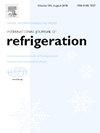制冷剂和润滑剂混合物管束喷雾蒸发传热模型
IF 3.5
2区 工程技术
Q1 ENGINEERING, MECHANICAL
International Journal of Refrigeration-revue Internationale Du Froid
Pub Date : 2025-06-24
DOI:10.1016/j.ijrefrig.2025.06.025
引用次数: 0
摘要
喷雾式蒸发器常用于建筑空调和工业制冷的大型冷水机组。喷雾式蒸发器减少制冷剂充注量,同时保持高能效。文献研究主要集中在喷雾蒸发的传热模型上。然而,从单管传热实验中获得的见解不能直接应用于管束。此外,文献中的模型忽略了润滑剂在系统中不可避免的存在。本文介绍了一种创新的半经验传热模型,该模型可以在考虑润滑剂的情况下预测管束内管道的传热系数。该模型也在R1234ze(E)/oil和R134a/POE混合物中进行了实验验证,考虑了束结构类型(方形与三角形)和管表面增强类型(沸腾与冷凝)。该模型采用了一种新颖的分段管束方法,考虑了润滑油的空间分布,预测了由于管束中的垂直位置而导致的管束HTC的下降。束下管的局部膜流速率降低,特别是在高热通量时。当考虑单管实验的HTC时,大约50%的HTC降解归因于束效应,其余50%归因于润滑剂。润滑剂对沸腾样管产生负面影响,而有时会增加束中使用的冷凝样管的HTC。当有油存在时,泡沫和膜破裂对束底管的影响最大,特别是当进料比小于2时。在浓度为1%时,热流密度大于15 kW/m2时,HTC降低30%以上。新模型使工程师能够根据管的几何形状、管束配置、制冷剂条件和使用中的特定制冷剂-润滑剂对来预测基于喷雾的管束蒸发器的性能。本文章由计算机程序翻译,如有差异,请以英文原文为准。
Heat transfer model of spray evaporation on tube bundles for refrigerant and lubricant mixtures
Spray-type evaporators are often used in large chillers for building air conditioning and industrial refrigeration. Spray-type evaporators reduce the refrigerant charge while maintaining high energy efficiency. Studies in the literature focused on heat transfer models for spray evaporation. However, the insights gleaned from single-tube heat transfer experiments cannot be directly applied to tube bundles. In addition, models in the literature overlook the inevitable presence of lubricant in the system.
This paper introduces an innovative semi-empirical heat transfer model that predicts the heat transfer coefficients (HTCs) of the tubes within the bundle while factoring in the lubricant. The model, which was also experimentally validated for R1234ze(E)/oil and R134a/POE mixtures, accounted for the type of bundle configuration (square vs. triangular) and type of tube surface enhancements (boiling vs condensing).
Utilizing a novel segmented tube bundle approach, the model considered the spatial distribution of lubricating oil to predict the decrease in the tube HTC due to their vertical placement in the bundle. The local film flow rates decreased for the lower tubes of the bundle, especially at high heat fluxes. When considering the HTC from single tube experiments, approximately 50% of the HTC degradation was attributed to the bundle effect, and the remaining 50% was due to the lubricant. The lubricant affected boiling-like tubes negatively, while sometimes increasing the HTC of condensing-like tubes used in the bundle. Foaming and film breakdown when oil was present affected the bottom tubes of the bundles the most, especially if the feed ratio was less than 2. At a concentration of 1%, the lubricant decreased the HTC by 30% or more if the heat flux was above 15 kW/m2. The new model enables engineers to forecast the performance of spray-based tube bundle evaporators based on tube geometry, bundle configuration, refrigerant conditions, and the specific refrigerant-lubricant pair in use.
求助全文
通过发布文献求助,成功后即可免费获取论文全文。
去求助
来源期刊
CiteScore
7.30
自引率
12.80%
发文量
363
审稿时长
3.7 months
期刊介绍:
The International Journal of Refrigeration is published for the International Institute of Refrigeration (IIR) by Elsevier. It is essential reading for all those wishing to keep abreast of research and industrial news in refrigeration, air conditioning and associated fields. This is particularly important in these times of rapid introduction of alternative refrigerants and the emergence of new technology. The journal has published special issues on alternative refrigerants and novel topics in the field of boiling, condensation, heat pumps, food refrigeration, carbon dioxide, ammonia, hydrocarbons, magnetic refrigeration at room temperature, sorptive cooling, phase change materials and slurries, ejector technology, compressors, and solar cooling.
As well as original research papers the International Journal of Refrigeration also includes review articles, papers presented at IIR conferences, short reports and letters describing preliminary results and experimental details, and letters to the Editor on recent areas of discussion and controversy. Other features include forthcoming events, conference reports and book reviews.
Papers are published in either English or French with the IIR news section in both languages.

 求助内容:
求助内容: 应助结果提醒方式:
应助结果提醒方式:


